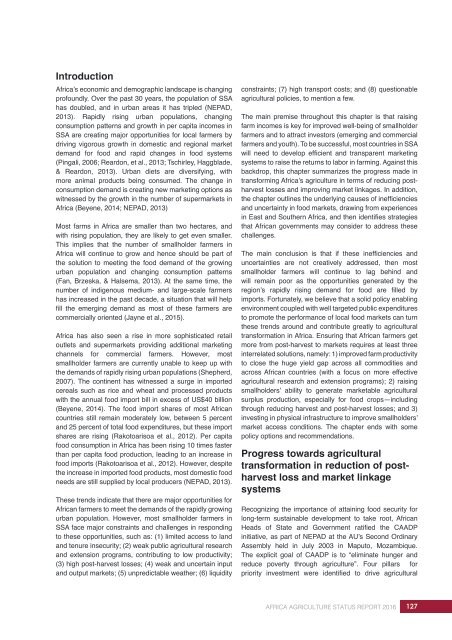AFRICA AGRICULTURE STATUS REPORT 2016
AASR-report_2016-1
AASR-report_2016-1
You also want an ePaper? Increase the reach of your titles
YUMPU automatically turns print PDFs into web optimized ePapers that Google loves.
Introduction<br />
Africa’s economic and demographic landscape is changing<br />
profoundly. Over the past 30 years, the population of SSA<br />
has doubled, and in urban areas it has tripled (NEPAD,<br />
2013). Rapidly rising urban populations, changing<br />
consumption patterns and growth in per capita incomes in<br />
SSA are creating major opportunities for local farmers by<br />
driving vigorous growth in domestic and regional market<br />
demand for food and rapid changes in food systems<br />
(Pingali, 2006; Reardon, et al., 2013; Tschirley, Haggblade,<br />
& Reardon, 2013). Urban diets are diversifying, with<br />
more animal products being consumed. The change in<br />
consumption demand is creating new marketing options as<br />
witnessed by the growth in the number of supermarkets in<br />
Africa (Beyene, 2014; NEPAD, 2013)<br />
Most farms in Africa are smaller than two hectares, and<br />
with rising population, they are likely to get even smaller.<br />
This implies that the number of smallholder farmers in<br />
Africa will continue to grow and hence should be part of<br />
the solution to meeting the food demand of the growing<br />
urban population and changing consumption patterns<br />
(Fan, Brzeska, & Halsema, 2013). At the same time, the<br />
number of indigenous medium- and large-scale farmers<br />
has increased in the past decade, a situation that will help<br />
fill the emerging demand as most of these farmers are<br />
commercially oriented (Jayne et al., 2015).<br />
Africa has also seen a rise in more sophisticated retail<br />
outlets and supermarkets providing additional marketing<br />
channels for commercial farmers. However, most<br />
smallholder farmers are currently unable to keep up with<br />
the demands of rapidly rising urban populations (Shepherd,<br />
2007). The continent has witnessed a surge in imported<br />
cereals such as rice and wheat and processed products<br />
with the annual food import bill in excess of US$40 billion<br />
(Beyene, 2014). The food import shares of most African<br />
countries still remain moderately low, between 5 percent<br />
and 25 percent of total food expenditures, but these import<br />
shares are rising (Rakotoarisoa et al., 2012). Per capita<br />
food consumption in Africa has been rising 10 times faster<br />
than per capita food production, leading to an increase in<br />
food imports (Rakotoarisoa et al., 2012). However, despite<br />
the increase in imported food products, most domestic food<br />
needs are still supplied by local producers (NEPAD, 2013).<br />
These trends indicate that there are major opportunities for<br />
African farmers to meet the demands of the rapidly growing<br />
urban population. However, most smallholder farmers in<br />
SSA face major constraints and challenges in responding<br />
to these opportunities, such as: (1) limited access to land<br />
and tenure insecurity; (2) weak public agricultural research<br />
and extension programs, contributing to low productivity;<br />
(3) high post-harvest losses; (4) weak and uncertain input<br />
and output markets; (5) unpredictable weather; (6) liquidity<br />
constraints; (7) high transport costs; and (8) questionable<br />
agricultural policies, to mention a few.<br />
The main premise throughout this chapter is that raising<br />
farm incomes is key for improved well-being of smallholder<br />
farmers and to attract investors (emerging and commercial<br />
farmers and youth). To be successful, most countries in SSA<br />
will need to develop efficient and transparent marketing<br />
systems to raise the returns to labor in farming. Against this<br />
backdrop, this chapter summarizes the progress made in<br />
transforming Africa’s agriculture in terms of reducing postharvest<br />
losses and improving market linkages. In addition,<br />
the chapter outlines the underlying causes of inefficiencies<br />
and uncertainty in food markets, drawing from experiences<br />
in East and Southern Africa, and then identifies strategies<br />
that African governments may consider to address these<br />
challenges.<br />
The main conclusion is that if these inefficiencies and<br />
uncertainties are not creatively addressed, then most<br />
smallholder farmers will continue to lag behind and<br />
will remain poor as the opportunities generated by the<br />
region’s rapidly rising demand for food are filled by<br />
imports. Fortunately, we believe that a solid policy enabling<br />
environment coupled with well targeted public expenditures<br />
to promote the performance of local food markets can turn<br />
these trends around and contribute greatly to agricultural<br />
transformation in Africa. Ensuring that African farmers get<br />
more from post-harvest to markets requires at least three<br />
interrelated solutions, namely: 1) improved farm productivity<br />
to close the huge yield gap across all commodities and<br />
across African countries (with a focus on more effective<br />
agricultural research and extension programs); 2) raising<br />
smallholders’ ability to generate marketable agricultural<br />
surplus production, especially for food crops—including<br />
through reducing harvest and post-harvest losses; and 3)<br />
investing in physical infrastructure to improve smallholders’<br />
market access conditions. The chapter ends with some<br />
policy options and recommendations.<br />
Progress towards agricultural<br />
transformation in reduction of postharvest<br />
loss and market linkage<br />
systems<br />
Recognizing the importance of attaining food security for<br />
long-term sustainable development to take root, African<br />
Heads of State and Government ratified the CAADP<br />
initiative, as part of NEPAD at the AU’s Second Ordinary<br />
Assembly held in July 2003 in Maputo, Mozambique.<br />
The explicit goal of CAADP is to “eliminate hunger and<br />
reduce poverty through agriculture”. Four pillars for<br />
priority investment were identified to drive agricultural<br />
<strong>AFRICA</strong> <strong>AGRICULTURE</strong> <strong>STATUS</strong> <strong>REPORT</strong> <strong>2016</strong><br />
127


